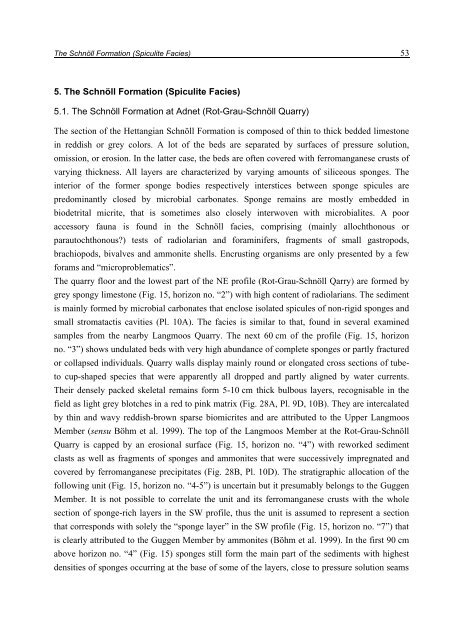Porifera-microbialites of the Lower Liassic (Northern Calcareous ...
Porifera-microbialites of the Lower Liassic (Northern Calcareous ...
Porifera-microbialites of the Lower Liassic (Northern Calcareous ...
You also want an ePaper? Increase the reach of your titles
YUMPU automatically turns print PDFs into web optimized ePapers that Google loves.
The Schnöll Formation (Spiculite Facies) 53<br />
5. The Schnöll Formation (Spiculite Facies)<br />
5.1. The Schnöll Formation at Adnet (Rot-Grau-Schnöll Quarry)<br />
The section <strong>of</strong> <strong>the</strong> Hettangian Schnöll Formation is composed <strong>of</strong> thin to thick bedded limestone<br />
in reddish or grey colors. A lot <strong>of</strong> <strong>the</strong> beds are separated by surfaces <strong>of</strong> pressure solution,<br />
omission, or erosion. In <strong>the</strong> latter case, <strong>the</strong> beds are <strong>of</strong>ten covered with ferromanganese crusts <strong>of</strong><br />
varying thickness. All layers are characterized by varying amounts <strong>of</strong> siliceous sponges. The<br />
interior <strong>of</strong> <strong>the</strong> former sponge bodies respectively interstices between sponge spicules are<br />
predominantly closed by microbial carbonates. Sponge remains are mostly embedded in<br />
biodetrital micrite, that is sometimes also closely interwoven with <strong>microbialites</strong>. A poor<br />
accessory fauna is found in <strong>the</strong> Schnöll facies, comprising (mainly allochthonous or<br />
parautochthonous?) tests <strong>of</strong> radiolarian and foraminifers, fragments <strong>of</strong> small gastropods,<br />
brachiopods, bivalves and ammonite shells. Encrusting organisms are only presented by a few<br />
forams and “microproblematics”.<br />
The quarry floor and <strong>the</strong> lowest part <strong>of</strong> <strong>the</strong> NE pr<strong>of</strong>ile (Rot-Grau-Schnöll Qarry) are formed by<br />
grey spongy limestone (Fig. 15, horizon no. “2”) with high content <strong>of</strong> radiolarians. The sediment<br />
is mainly formed by microbial carbonates that enclose isolated spicules <strong>of</strong> non-rigid sponges and<br />
small stromatactis cavities (Pl. 10A). The facies is similar to that, found in several examined<br />
samples from <strong>the</strong> nearby Langmoos Quarry. The next 60 cm <strong>of</strong> <strong>the</strong> pr<strong>of</strong>ile (Fig. 15, horizon<br />
no. “3”) shows undulated beds with very high abundance <strong>of</strong> complete sponges or partly fractured<br />
or collapsed individuals. Quarry walls display mainly round or elongated cross sections <strong>of</strong> tube-<br />
to cup-shaped species that were apparently all dropped and partly aligned by water currents.<br />
Their densely packed skeletal remains form 5-10 cm thick bulbous layers, recognisable in <strong>the</strong><br />
field as light grey blotches in a red to pink matrix (Fig. 28A, Pl. 9D, 10B). They are intercalated<br />
by thin and wavy reddish-brown sparse biomicrites and are attributed to <strong>the</strong> Upper Langmoos<br />
Member (sensu Böhm et al. 1999). The top <strong>of</strong> <strong>the</strong> Langmoos Member at <strong>the</strong> Rot-Grau-Schnöll<br />
Quarry is capped by an erosional surface (Fig. 15, horizon no. “4”) with reworked sediment<br />
clasts as well as fragments <strong>of</strong> sponges and ammonites that were successively impregnated and<br />
covered by ferromanganese precipitates (Fig. 28B, Pl. 10D). The stratigraphic allocation <strong>of</strong> <strong>the</strong><br />
following unit (Fig. 15, horizon no. “4-5”) is uncertain but it presumably belongs to <strong>the</strong> Guggen<br />
Member. It is not possible to correlate <strong>the</strong> unit and its ferromanganese crusts with <strong>the</strong> whole<br />
section <strong>of</strong> sponge-rich layers in <strong>the</strong> SW pr<strong>of</strong>ile, thus <strong>the</strong> unit is assumed to represent a section<br />
that corresponds with solely <strong>the</strong> “sponge layer” in <strong>the</strong> SW pr<strong>of</strong>ile (Fig. 15, horizon no. “7”) that<br />
is clearly attributed to <strong>the</strong> Guggen Member by ammonites (Böhm et al. 1999). In <strong>the</strong> first 90 cm<br />
above horizon no. “4” (Fig. 15) sponges still form <strong>the</strong> main part <strong>of</strong> <strong>the</strong> sediments with highest<br />
densities <strong>of</strong> sponges occurring at <strong>the</strong> base <strong>of</strong> some <strong>of</strong> <strong>the</strong> layers, close to pressure solution seams

















